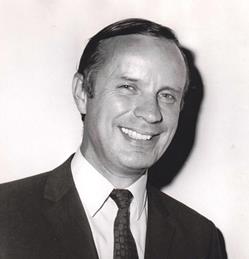 Curator of the Geological Museum who began its modernisation only to see it subsumed as the Natural History Museum ‘Earth Galleries’
Curator of the Geological Museum who began its modernisation only to see it subsumed as the Natural History Museum ‘Earth Galleries’
When Fred Dunning was appointed Curator of the Geological Museum in 1970, his aim was to completely replace its antiquated displays, and instead to convey up-to-the-moment geological research to the museum's visitors, and to make it accessible through simple text and eye-catching displays.
He appointed designer James Gardner to realise the first stage of transforming the Geological Museum, with the Story of the Earth exhibition, opened by the Queen in 1972. The Story began inside a mysterious cleft in a rock face, a replica of a Moinian outcrop near Mallaig. In the dark space, the story began with the origin of chemical elements in stars. The visitor eventually re-entered the everyday world on an earthquake shaking-table. For transforming the Geological Museum into one of the most popular attractions in London, Fred was awarded the OBE. By his retirement in 1988, more than half the Museum’s exhibition space was filled with modern displays.
Fred was unsatisfied with the level and quantity of information an exhibition could hold: his answer lay in a series of colour-illustrated small books the visitors could buy and read at home. These books have been so widely copied by other organisations, it is hard to remember just how revolutionary they were. Fred also fostered and expanded the Museum’s outreach programme. As well as activities for schools, there were adult education courses, professional development courses for the stone industry, and geological field excursions for the public within the UK and abroad.
An unfortunate consequence of the relocation of the Museum's parent organisation, the British Geological Survey, to Keyworth was that the Geological Museum became absorbed into the Natural History Museum, as ‘The Earth Galleries’. In 1990 Fred commented in the geological press ‘a conscious policy of reducing the profile of geology… the Geological Museum has been abolished… its functions crippled’, its education programme ‘stopped dead in mid-programme’…’its world-famous booklet series … come to an end’.
Fred was active beyond the confines of the Geological Museum; within the Geological Society he was Foreign Secretary, also Secretary of the Dining Club. In 1988, Fred was awarded the Geological Society’s Coke medal. He collated the mapchart Geological Structure of Great Britain, Ireland and surrounding seas, published by the Geological Society in 1985. Working with regional museums, Fred pushed for establishment of the Travelling Geology Curator post to assess the totality of geological material in UK Museums. After retirement, he became a member of the Museums and Galleries Commission.
In retirement, Fred followed his passion for gardening, producing guide books and explanatory panels for north-country gardens Harlow Carr, Holehird, and Otley Chevin Nature Reserve. He was editor of The Northern Gardener.
Fred's perfectionism pervaded his output, whether scholarly publications, such as the The Tectonic Map of the UK, editorship of The Mineral Deposits of Europe, or his popular opus.
In 1950 he married Ingeborg Firth, who predeceased him. He is survived by their two children, Jane and Andrew, and his twin brother John. Fred died of heart failure in April, in Yorkshire.
Compiled and presented by Susanna van Rose who particularly thanks Anthony Barber, Jane Friend, Gary Hincks, Crispin Paine and Ian Mercer for their reminiscences and contributions. Fred’s daughter Jane Osborne, shared some of Fred's own contributions.